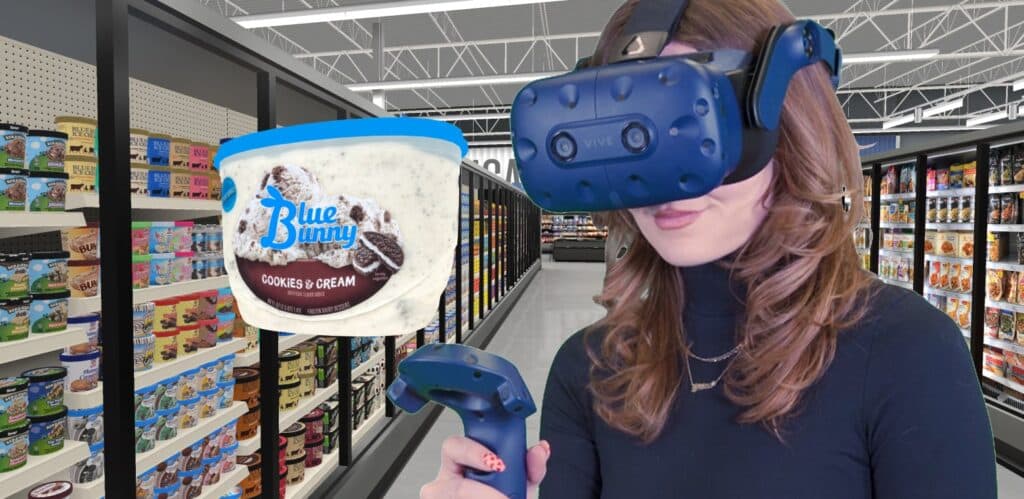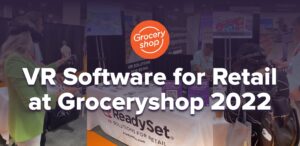Ice Cream Category Leverages VR Innovation for Sales Growth

Learn about new virtual reality retail planning and research solutions aimed to assist ice cream industry growth amid recent sales decline.
The ice cream industry has faced a noticeable decline in unit sales since the pandemic, as reported by Kroger’s retail data science company 84.51˚. Their ice cream industry analysis showcased inflation driving a modest 1% increase in ice cream sales revenue for the 52 weeks ending June 8. With bulk purchases, such as six-quart-sized ice cream containers, surging by 35% over the last year.
This data suggests the latest pivot in consumer preferences as fewer people indulge in treats at home and if so, lean towards bulk purchasing. Although some frozen dessert industry products are holding a promising sales outlook, most are looking to improve their performance. In order to achieve these goals, innovation focused ice cream manufacturers are turning to emerging technologies like Virtual Reality (VR) to accelerate their market research process.
While traditional market analysis provides insights into current ice cream industry trends and growth rates, it often lags behind the rapidly evolving consumer landscape. Understanding whether consumers prefer something with health benefits or indulging in regular ice cream as a treat has become more complex. This is where VR solutions come into play, offering a cutting-edge approach to the ice cream innovation process. Providing a market research and retail planning method that can keep pace with these changes.

Virtual Reality as a Catalyst for Future of Ice Cream Industry Growth
Virtual reality retail planning and shopper research are revolutionizing how manufacturers understand and respond to ice cream market trends. By leveraging VR, companies can gain detailed insights into regional consumption patterns, the performance of different flavors, and the preferences of health-conscious consumers—all in a cost-effective and time-efficient manner.
3D Ice Cream Assortment Planning
Advanced 3D models of frozen treats allow ice cream brands like Ben & Jerry’s and Häagen-Dazs to ideate and test new freezer aisle planograms in a virtual space. This enables them to experiment with various assortment organizations and product placements quickly, without the constraints of physical testing. VR research allows for limitless variants to be tested, helping companies optimize their ice cream product offerings and shelf layouts to better meet consumer demand.

Immersive Virtual Shopper Research
Virtual research can be conducted in two primary ways: through interactive navigation on a computer or via immersive, life-size shopping experiences. These methods provide deep insights through data collection and analytics, including eye-tracking technology, which can help predict the performance of both traditional dairy products and dairy-free alternatives.
These digital experiences offer a comprehensive view of consumer preferences. Whether you're testing the consumption of ice cream, the appeal of different flavored ice creams, or comparing vegan ice cream to traditional ice cream options, this technology provides valuable insights across the entire frozen dessert market. Additionally, the global ice cream market can be assessed through online studies, making it easier for brands to understand and respond to regional variations in consumer behavior.

Conclusion
As the ice cream industry navigates a changing market, VR offers a powerful tool for staying ahead of trends. By embracing virtual research methods, manufacturers can not only address current sales declines but also uncover new opportunities for growth in an increasingly competitive landscape.
Subscribe to our newsletter
Get our blogs and the latest retail news delivered to your inbox monthly.
Recent Posts
What is Digital Twin Technology and How it helps Retail 2023
Digital twins in the retail industry are virtual replica stores that can help retailers reduce costs, improve efficiency, and increase productivity. The term digital twin has entered the vocabulary of retail industry experts and leaders. But what does it mean? We will explore the definition, use cases, examples, softwares and common questions associated with digital…
2022 Holiday Shopping Trends & How Brands can be Successful
Consumer trends for this year’s holiday shopping season include spending less and shopping early. Learn how your brand can make it to the cart. The holiday season is fast approaching and this year is unlike many others. Consumers are battling record high inflation, persisting supply chain issues, a labor shortage, increased gas prices and continued…
Virtual Reality Software for Retail at Groceryshop 2022
This year’s show featured a new virtual reality shopping technology for retailers and brands to enhance consumer experiences. The Groceryshop conference in Las Vegas is a leading event for CPG brands, supermarkets, c-stores, drug stores, discount stores, warehouse clubs and other grocery retailers. This year’s Groceryshop Vegas was held at Mandalay Bay on September 19-22. The…



